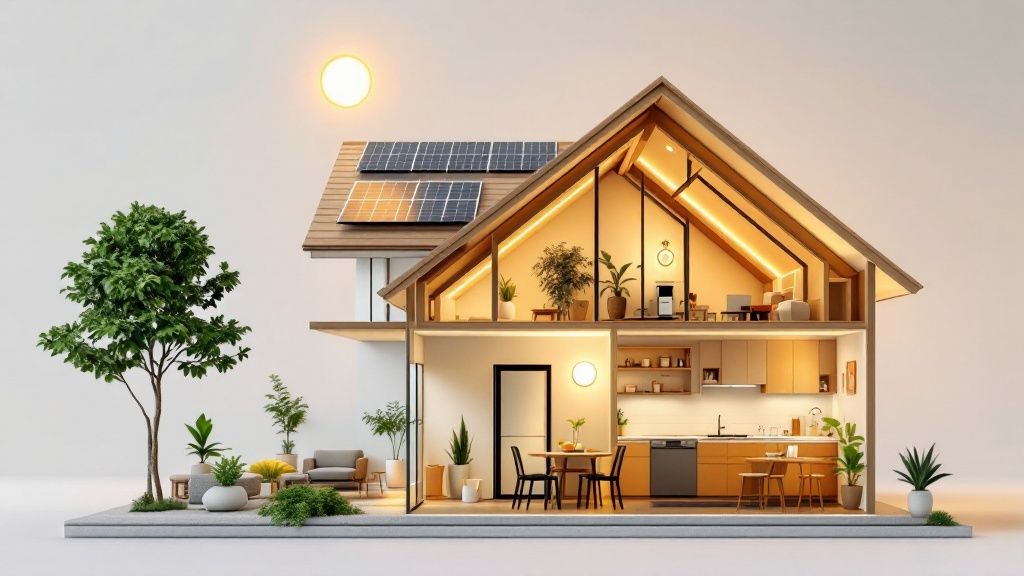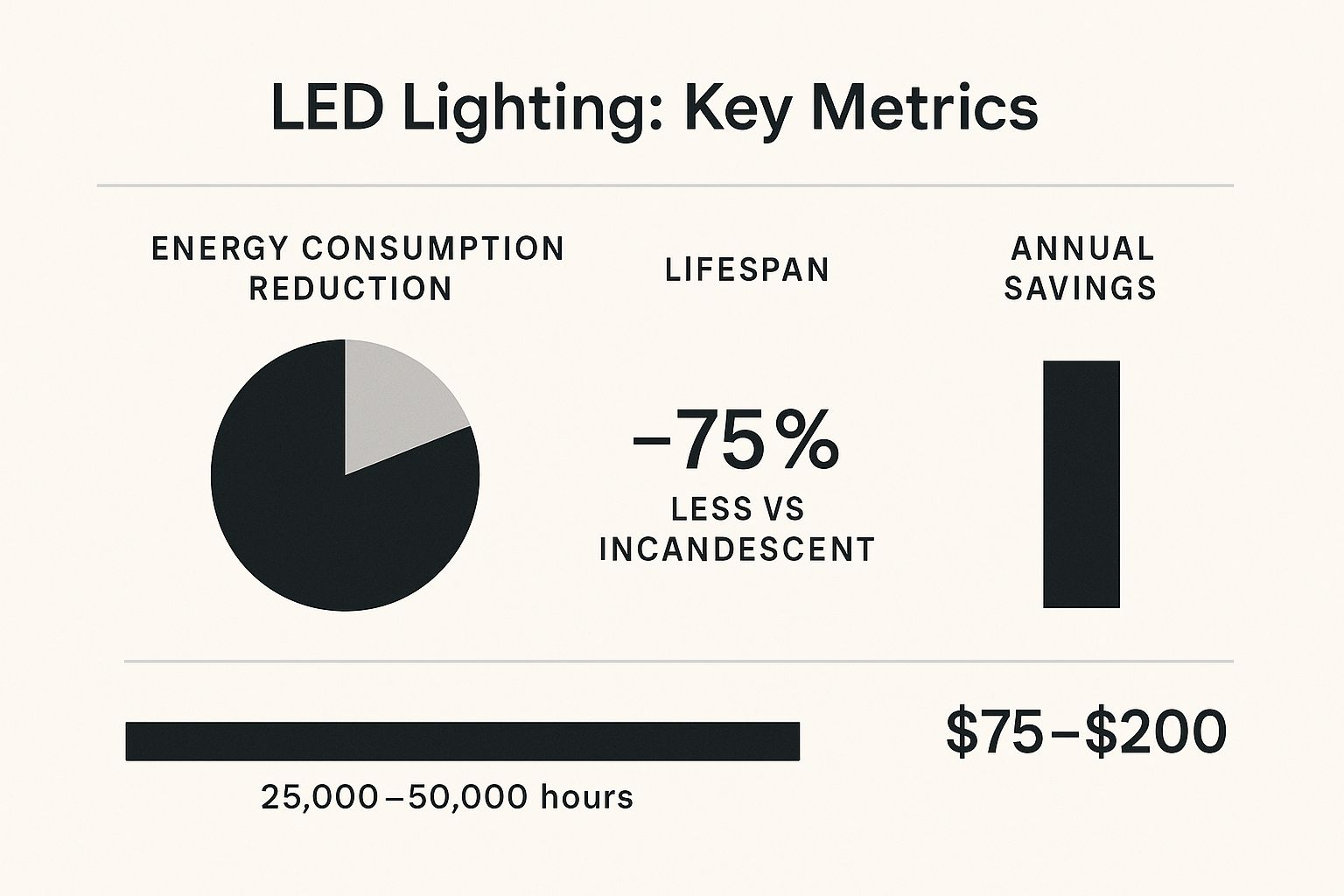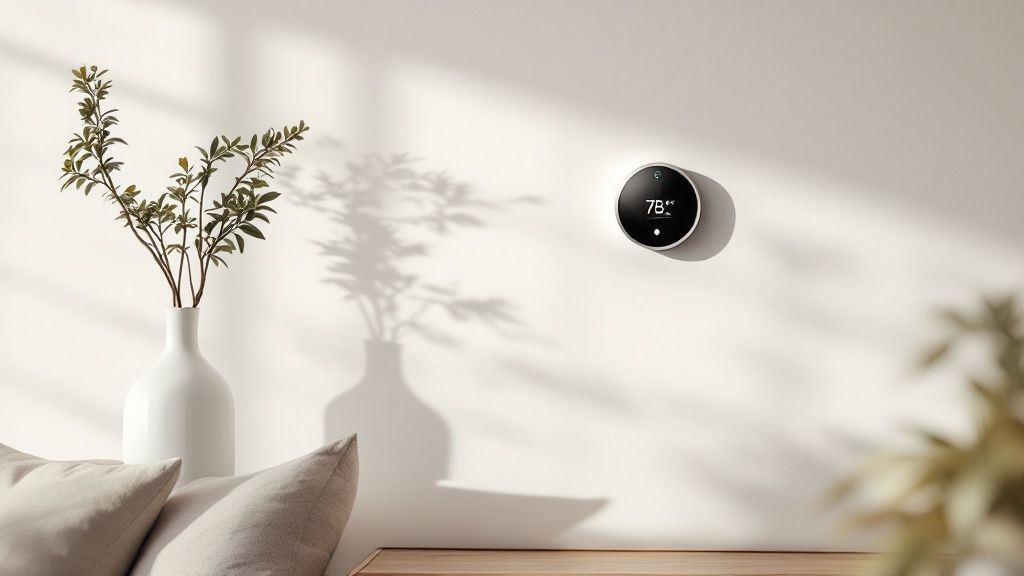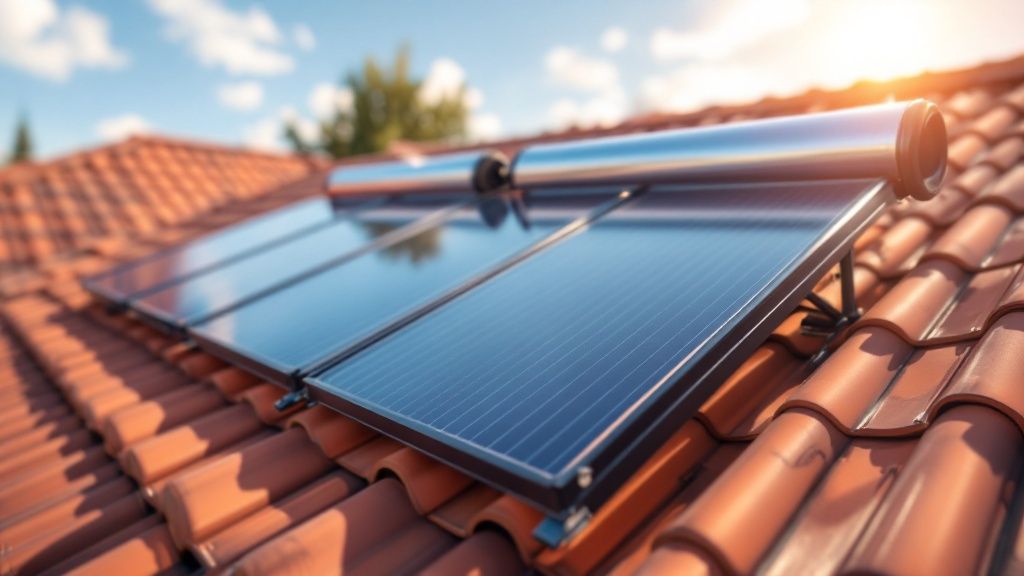
Top 10 Ways to Make Your Home More Energy Efficient in 2025
Creating a home that’s both comfortable and cost-effective is a goal we all share. In a world where every kilowatt counts, finding smart ways to make your home more energy efficient not only helps your wallet but also supports a healthier planet.
1. Upgrade to LED Lighting
One of the simplest yet most impactful ways to make your home more energy efficient is by switching from traditional incandescent bulbs to modern LED (Light Emitting Diode) lighting. This is a brilliant first step toward a greener, more cost-effective household.
LEDs use up to 75% less energy and last up to 25 times longer than their old-fashioned counterparts. Instead of heating a filament, they pass an electrical current through a microchip, which illuminates tiny light sources—a far more efficient process.
Why Make the Switch?
- Significant Savings: A typical home can save over $75 annually on electricity bills just by replacing its most-used bulbs.
- Long-Lasting: The extended lifespan of LEDs means fewer replacements and less maintenance, saving you time and money.
- Cool Operation: Unlike incandescent bulbs that release most of their energy as heat, LEDs stay cool to the touch, which can help reduce home cooling costs.
This chart clearly visualizes the compelling advantages of switching to LEDs.

How to Get Started
- Start with high-traffic areas: Replace the bulbs in your most frequently used fixtures first, such as in the kitchen, living room, and hallways.
- Choose the right color: Look for a color temperature between 2700K and 3000K for a warm, inviting light similar to traditional bulbs.
- Look for certification: Prioritize ENERGY STAR certified LEDs to ensure quality, performance, and verified energy savings.
2. Improve Home Insulation
Proper insulation acts as a crucial thermal barrier, significantly reducing heat transfer between your home and the outside environment. It's a powerful way to keep your living spaces warmer during winter and cooler in summer.
Insulation's effectiveness is measured by its R-value—the higher the R-value, the better it resists heat flow. By adding or upgrading insulation in key areas like the attic, walls, and basement, you can drastically reduce your heating and cooling needs.
Why Make the Switch?
- Substantial Savings: Upgrading attic insulation in a cold climate from R-11 to R-49 may save hundreds of dollars annually on heating costs.
- Enhanced Comfort: A well-insulated home maintains a more consistent indoor temperature by eliminating cold drafts and hot spots.
- Quieter Home: Improved insulation also provides soundproofing benefits, creating a more peaceful living environment.
How to Get Started
- Prioritize the attic: Since heat rises, the attic is often the source of the greatest heat loss, making it the most cost-effective area to insulate first.
- Seal air leaks first: Before adding insulation, seal any gaps around windows, pipes, and wiring to prevent conditioned air from escaping.
- Check local codes: Consult your local building codes to determine the minimum recommended R-values for your climate zone.
- Consider a professional audit: An energy auditor can help pinpoint the exact areas in your home that need the most attention.
3. Install a Programmable or Smart Thermostat
Upgrading your manual thermostat to a programmable or smart model is one of the most effective ways to make your home more energy efficient. This simple change automates your home's heating and cooling, ensuring you only use energy when needed.
Smart thermostats learn your daily routines and automatically adjust the temperature for optimal comfort and savings. They can even be controlled remotely via a smartphone app, giving you complete command over your home's climate from anywhere.

Why Make the Switch?
- Cost Savings: Users of popular smart thermostats report average savings of 10-12% on heating and 15% on cooling bills. Over a year, these savings can easily pay for the device itself.
- Enhanced Comfort: These devices maintain consistent temperatures, eliminating the need for constant manual adjustments.
- Actionable Insights: Many smart thermostats provide detailed energy usage reports, empowering you to make even smarter decisions.
How to Get Started
- Schedule for savings: Program your thermostat to lower the temperature by 7-10°F when you are asleep or away from home.
- Proper placement is key: Install your thermostat on an interior wall, away from direct sunlight, drafts, and heat sources.
- Check for rebates: Many utility companies offer rebates for purchasing ENERGY STAR certified smart thermostats.
4. Seal Air Leaks and Weatherstrip
One of the most cost-effective ways to make your home more energy efficient is to find and seal hidden air leaks. These tiny cracks around windows, doors, and outlets can sabotage your heating and cooling efforts, making your HVAC system work much harder.
The average American home has enough air leaks to equal leaving a window open 24/7. By using caulk and weatherstripping to address these gaps, you prevent energy waste and improve overall home comfort.
Why Make the Switch?
- Significant Savings: Homeowners may save up to 20% on heating and cooling costs just by sealing leaks and adding insulation.
- Improved Air Quality: Sealing your home helps keep outdoor pollutants, dust, and allergens out.
- Immediate Impact: Unlike larger projects, you’ll feel the difference in comfort and see the savings almost immediately.
This video demonstrates how to find and fix some of the most common air leaks around your home.
How to Get Started
- Perform a simple audit: On a windy day, carefully hold a lit incense stick near common leak areas. Where the smoke wavers, you have a leak.
- Prioritize the biggest gaps: Focus first on larger openings in your attic, crawl space, and basement, as these often account for the most energy loss.
- Use the right materials: Use caulk for small cracks (less than 1/4-inch) and expanding foam sealant for larger openings. Add or replace weatherstripping around doors and windows for a tight seal.
5. Upgrade to Energy-Efficient Windows
Your windows are a major source of heat loss in winter and heat gain in summer. Upgrading to modern, energy-efficient windows is a transformative step that enhances comfort and significantly lowers utility bills.
These windows use advanced technologies, like double or triple panes of glass separated by an insulating gas. A microscopic, low-emissivity (low-E) coating reflects heat, keeping it inside during winter and outside during summer.
Why Make the Switch?
- Lower Energy Bills: Replacing old single-pane windows with ENERGY STAR certified models can save homeowners between $126 and $465 annually.
- Year-Round Comfort: Energy-efficient windows reduce drafts, minimize condensation, and create a more stable indoor temperature.
- Protect Your Interior: The low-E coating also blocks harmful UV rays, protecting your furniture, floors, and artwork from fading.
How to Get Started
- Prioritize worst-performers: Start by replacing the oldest, leakiest, or single-pane windows first for the most immediate impact.
- Check for certifications: Always look for the ENERGY STAR label to ensure the windows meet strict energy performance standards for your climate zone.
- Explore incentives: Research local utility and government rebates or tax credits that can help offset the initial cost.
- Consider frame materials: Vinyl, wood, and fiberglass frames offer different levels of insulation and maintenance. Choose one that balances performance, aesthetics, and your budget.
6. Install Energy-Efficient Appliances
Upgrading major appliances is a powerful way to make your home more energy efficient, as these devices account for a significant portion of household energy use. ENERGY STAR certified appliances are designed to be 10-50% more efficient than standard models.
They achieve this through features like variable-speed motors, improved insulation, and smart controls that optimize performance. Swapping an old appliance for a new, efficient model provides substantial long-term savings.
Why Make the Switch?
- Drastic Energy Reduction: A new ENERGY STAR certified refrigerator uses about 40% less energy than a model from 2001.
- Lower Utility Bills: High-efficiency washing machines may save you around $40 annually in energy costs alone, not including water savings.
- Superior Performance: Modern appliances often offer better features and smarter technology, enhancing your daily routines.
How to Get Started
- Time it right: The most cost-effective time to upgrade is when an old appliance fails, avoiding the premature cost of a new unit.
- Compare EnergyGuide labels: This mandatory yellow label provides an estimate of the annual energy consumption and operating cost, making comparisons easy.
- Choose the right size: Select appliances that fit your household’s actual needs. An oversized appliance will consume more energy than necessary.
- Check for rebates: Many utility companies and local governments offer rebates for purchasing ENERGY STAR certified products.
7. Upgrade HVAC System and Maintenance
Your home's heating, ventilation, and air conditioning (HVAC) system is one of its largest energy consumers. Upgrading to a modern, high-efficiency unit and performing regular maintenance are crucial for an energy-efficient home.
Modern HVAC systems are designed to provide superior climate control while using significantly less power. Look for a SEER (Seasonal Energy Efficiency Ratio) rating of 16 or higher for cooling and an AFUE (Annual Fuel Utilization Efficiency) rating of 90% or more for heating.
Why Make the Switch?
- Massive Savings: High-efficiency units, such as heat pumps, may reduce your heating and cooling costs by up to 50%.
- Increased Lifespan: Regular upkeep, like changing filters and scheduling professional tune-ups, ensures the system runs at peak performance and lasts longer.
- Improved Air Quality: A well-maintained system with clean filters helps circulate cleaner air throughout your home. For more information, check out these helpful tips to make your HVAC system more energy efficient.
How to Get Started
- Prioritize Regular Maintenance: Change your air filters every 1-3 months. Keeping home components clean is essential, and you can explore more unique cleaning solutions at Wonders Emporium Shop.
- Schedule Annual Tune-Ups: Have a professional inspect your system annually to ensure it operates safely and efficiently.
- Consider a Modern Upgrade: If your system is over 10 years old, evaluate upgrading to a high-efficiency model.
- Ensure Proper Sizing: Work with a professional to ensure your new equipment is correctly sized for your home to avoid wasted energy.
8. Install Solar Water Heating
Harnessing the sun's power to heat your water is a highly effective way to reduce utility bills. Solar water heating systems use collectors, typically installed on your roof, to absorb solar energy and transfer that heat to water stored in a tank.
This directly tackles one of a home's largest energy consumers—water heating can account for nearly 20% of a household's energy expenses. By using clean, renewable solar power, you may cut this cost by 50-80%.

Why Make the Switch?
- Long-Term Savings: In sunny climates, the payback period for a solar water heating system can be as short as four to eight years. After that, the hot water it produces is virtually free.
- Eco-Friendly: This upgrade significantly reduces your home’s carbon footprint by relying on a clean energy source.
- Increased Home Value: Homes with solar installations are often more attractive to buyers and may have a higher resale value.
How to Get Started
- Assess your property: Evaluate your roof's orientation (south-facing is ideal in the Northern Hemisphere) and ensure it receives ample sunlight.
- Size your system: Work with a professional to size the system to meet about 60-70% of your household's hot water needs.
- Choose the right type: Consider a drain-back system if you live in an area prone to freezing temperatures to prevent damage.
- Explore incentives: Maximize your return on investment by taking advantage of federal, state, and local tax credits or rebates.
9. Use Window Treatments for Temperature Control
One of the most approachable ways to make your home more energy efficient is by strategically using window treatments. The right blinds, shades, or curtains can significantly improve your home's insulation and regulate indoor temperatures.
In warmer months, they block solar radiation, reducing the load on your air conditioner. In colder months, they trap a layer of air, providing insulation that keeps warmth inside.
Why Make the Switch?
- Cost-Effective: This is a lower-cost alternative to full window replacement with a high impact on your energy bills.
- Immediate Comfort: You'll feel the difference in your home's temperature right away.
- Aesthetic and Functional: Window treatments add style and privacy while also saving you money. Properly installed cellular shades, for instance, may reduce heat loss through windows by 40% or more. Explore a comprehensive guide on various energy-efficient window treatments to learn more.
How to Get Started
- Be strategic with the sun: Close south- and west-facing window treatments during hot, sunny days in the summer. In the winter, open them to let in natural solar warmth.
- Layer for maximum effect: Combine treatments, such as pairing blinds with heavy drapes, to create a more effective insulating barrier.
- Choose the right materials: Opt for cellular (honeycomb) shades, which are designed with pockets that trap air. For hot climates, light-colored curtains that reflect sunlight are an excellent choice.
10. Implement Water Conservation Measures
Conserving water is a powerful and often overlooked way to make your home more energy efficient. Since water heating accounts for roughly 18% of a household's energy use, reducing your hot water usage directly lowers your utility bills.
This strategy focuses on decreasing the overall amount of water your home uses, especially heated water. By upgrading fixtures, using appliances efficiently, and adopting mindful habits, you can achieve significant savings.
Why Make the Switch?
- Dual Savings: You save on both your water and energy bills simultaneously.
- Resource Protection: Conserving water is an important step in protecting our planet's precious natural resources.
- Compounding Benefits: Small changes, like fixing a leaky faucet or washing clothes in cold water, add up to substantial savings over time.
How to Get Started
- Fix leaks immediately: A small drip from a hot water faucet can waste hundreds of gallons of heated water per year.
- Wash laundry in cold water: Whenever possible, use cold water for washing clothes to eliminate the energy draw from your water heater.
- Install low-flow fixtures: Replace older showerheads and faucet aerators with modern, efficient models to reduce hot water consumption.
- Take shorter showers: Aim to reduce shower times by a few minutes to significantly cut down on hot water use.
Energy Efficiency Measures Comparison
| Energy Efficiency Measure | Implementation Complexity 🔄 | Resource Requirements ⚡ | Expected Outcomes 📊 | Ideal Use Cases 💡 | Key Advantages ⭐ |
|---|---|---|---|---|---|
| Upgrade to LED Lighting | Low to Moderate 🔄 (simple bulb swap) | Low ⚡ (bulbs, compatible dimmers) | 75% energy reduction, long lifespan 📊 | Homes and businesses replacing bulbs | High savings, long life, low maintenance ⭐ |
| Improve Home Insulation | Moderate to High 🔄 (installation) | Moderate to High ⚡ (materials, labor) | 30-50% HVAC cost reduction, improved comfort 📊 | Homes needing better thermal barrier | Significant cost savings, comfort gain ⭐ |
| Install a Programmable or Smart Thermostat | Moderate 🔄 (setup, possible install) | Low to Moderate ⚡ (device, WiFi) | 10-15% energy savings, remote control 📊 | Homes seeking automated HVAC control | User-friendly, energy insights, convenience ⭐ |
| Seal Air Leaks and Weatherstrip | Low to Moderate 🔄 (DIY or pro options) | Low ⚡ (caulk, weatherstripping) | Immediate savings, reduced drafts 📊 | Homes with drafty windows and doors | Most cost-effective measure, quick impact ⭐ |
| Upgrade to Energy-Efficient Windows | High 🔄 (professional install) | High ⚡ (costly materials, labor) | 25-50% reduction in heat loss 📊 | Homes with old or single-pane windows | Comfort improvement, value increase ⭐ |
| Install Energy-Efficient Appliances | Moderate 🔄 (appliance swap) | Moderate to High ⚡ (cost varies) | 10-50% energy reduction per appliance 📊 | When upgrading or replacing appliances | Lower operating costs, rebates ⭐ |
| Upgrade HVAC System and Maintenance | High 🔄 (professional install + upkeep) | High ⚡ (equipment and service) | 20-40% energy savings, better air quality 📊 | Homes upgrading HVAC or needing efficiency | Improved comfort, longevity, value ⭐ |
| Install Solar Water Heating | High 🔄 (installation and space need) | High ⚡ (panels, tanks, installer) | 50-80% water heating cost reduction 📊 | Suitable roofs in sunny climates | Large savings, eco-friendly ⭐ |
| Use Window Treatments for Temperature Control | Low 🔄 (easy to install) | Low ⚡ (materials, DIY-friendly) | 10-40% heating/cooling load reduction 📊 | Homes seeking low-cost window improvements | Dual heating/cooling benefit, privacy ⭐ |
| Implement Water Conservation Measures | Low to Moderate 🔄 (fixture upgrade) | Low to Moderate ⚡ (fixtures, behavior) | Reduces water & energy bills 📊 | Homes with high water or energy use | Environmental benefit, rebates ⭐ |
Your Journey to an Efficient Home Starts Now
Embarking on the path to a more energy-efficient home is a journey of many manageable steps. We've covered a wide array of ways to make your home more energy efficient, providing a toolkit for homeowners ready to make a change.
Remember that progress, not perfection, is the goal. Your journey might begin with a simple weekend project, like sealing air leaks, or programming your smart thermostat. Every kilowatt-hour saved contributes to a healthier planet and a healthier budget.
Your Actionable Next Steps
Feeling inspired? Here’s how to turn that inspiration into action:
- Conduct a Home Energy Audit: Start by identifying your home’s biggest energy drains. A simple DIY audit can help you prioritize the most impactful upgrades.
- Create a Prioritized Action Plan: Based on your audit and budget, select one or two strategies from this guide to tackle first. Low-cost changes are excellent starting points.
- Set a Realistic Budget and Timeline: Plan your larger investments over time and research available rebates and tax credits to make them more affordable.
At Wonders Emporium Shop, a business proudly Owned & Operated by Boricua Innovations LLC., we share a passion for empowerment through smart, high-quality solutions. We believe that a well-cared-for home is the foundation for a better future, and we are here to support you with our commitment to unique products, Puerto Rican pride, and exceptional customer care.
Ready to find the perfect tools to kickstart your efficiency projects? Explore our curated collections at Wonders Emporium Shop to discover innovative products that align with your new energy-saving goals. Let us help you build a smarter, more sustainable home today.

